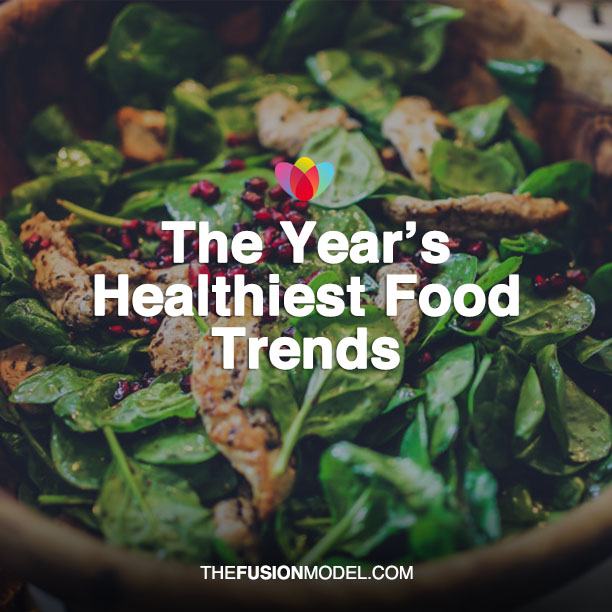The year 2013 was a bit of a bizarre year entertainment-wise (twerking, anyone?), but, from a nutritional standpoint, the year was stacked with a range of delectable options for anyone looking to get healthier. A number of food trends hit the mainstream in 2013, from relatively new concepts to resurrected oldies and some nearly unpronounceable (but awesome) options.
Kale
Traditionally, kale has taken a backseat to its veggie cousins broccoli, spinach and collard greens. As more and more people get word of kale’s many superpowers — it’s stellar for your heart, lowers cholesterol, is high in fiber and antioxidants, fights cancer and boosts energy — the cruciferous vegetable is skyrocketing in popularity. Seriously, it’s practically the 2013 prom queen of the health world. Intrigued, but not sure what to do with this leafy green? A lot of people start with kale chips, which are both yummy and healthy.
Restaurant Nutritional Info
A few months ago, I pulled up to the drive-through of my local chain hamburger joint. One look at the friggin’ absurd calorie info posted sent me screaming into the Great Beyond with only a diet soda clutched in my hot little hand. Like many people, I always knew that fast-food restaurant options were stacked with calories and fat, but I grossly underestimated by how much. Although more and more restaurants are adopting this full-disclosure policy via their menu or order board, a recent Gallup survey discovered that less than half of their customers pay it any mind. Since I’m a glass-is-half-full type of person, I’ll be pulling for a huge uptick in the popularity of the nutritional-info trend come 2014.
Quinoa
Figuring out how to pronounce this seed’s name may be tricky, but one thing’s for certain: Quinoa is nutritionally excellent. “It contains a high amount of protein, which is especially great for vegetarians,” says Lyssie Lakatos. If you’re having a hard time picturing it, quinoa is cooked exactly like rice, and it can be enjoyed as part of a salad or, like oatmeal, topped with cinnamon and berries. Some newfangled burger spots even offer quinoa burgers in place of the standard red-meat variety.
Gluten-Free Restaurant Bread And Pasta Options
One of my friends has celiac disease. Back when she was diagnosed, few people had heard of gluten, a specific type of protein found in many grains that people suffering from celiac disease can’t tolerate. As a result, she was pretty much forced to order salads at restaurants because gluten is in everything. Pasta. Bread. Marinades. Beer. Now that celebrities have popularized gluten-free diets, however, menus are popping up everywhere featuring breads and pastas that don’t contain the offending protein. This is great for people who suspect they have a gluten intolerance or wheat allergy. Unfortunately, many people confuse gluten-free with fat- and calorie-free, which is a problem because these products often feature more added ingredients (such as fat) than run-of-the-mill bread or pasta.
Juicing
Juicing has been around for years, but really surged in 2013 as more people looked for ways to work fruits and veggies into their daily diets. We all know that we’re supposed to eat a lot of them (between five and 13 servings a day), but often have a tough time meeting that lofty goal. Feel free to hop on the bandwagon and enjoy a variety of nutrient-rich options from the convenience of your favorite glass. Just be sure to keep an eye on your intake, and talk to your doctor, particularly if you have blood glucose issues. Even 100-percent-natural fruit juices contain calories and natural sugars, which can affect your blood sugar and your waistline.
Green Smoothies
Like juicing, green smoothies took off in 2013 thanks to their supreme nutritional content and sheer convenience. Some people concoct fruit smoothies with added veggies, while others stick to straight-up greens. Either way, smoothies are an excellent way to boost and maintain nutrition. “The good thing about a smoothie [compared with juicing] is that you’re not juicing out the fiber,” explains Tammy Lakatos Shames, RD. “Just be careful with any smoothie, because the amount of calories can get out of control.” If you’re just dipping your toe in the green smoothie waters, Shames suggests spinach because of its mild taste, blended with vanilla yogurt, frozen strawberries and water, skim milk or almond milk.
Diet Apps And Gadgets
While some people do just fine eyeballing nutrition and activity levels, many of us significantly underestimate our caloric intake and overestimate our exercise. As a result, many people are turning to health and wellness technology to get the job done. Free apps like My Fitness Pal and My Calorie Counter, which make keeping track of nutrition and exercise surprisingly easy, are growing more popular by the minute. Wrist-worn gadgets like Fitbit track everything from steps to calories burned to distance covered, among other things. Smartwatches are also growing in popularity, although features vary between models, with some monitoring heart rate and others offering full access to fitness apps.
Veggies
People want to be healthy, but they also want to eat out once in a while without totally going off the nutritional rails. Restaurants are getting the message, with menus showing an 11 percent increase in vegetables as side items and even main dishes since 2010. As the obesity epidemic rages on, more people — even non-vegans — are taking a long hard look at their plates and featuring nutrient-rich veggies more prominently as part of their daily diet. “There’s nothing better you can do for your body [than eat veggies],” says Shames. “Every study shows that it never hurts — and always helps.”
Veganism
Veganism has come a long way in recent years, moving from a little-known cousin of vegetarianism to a full-fledged nutritional movement. As of a 2012 Gallup poll, only two percent of Americans consider themselves vegan, but that’s still a pretty significant shift from the days when few people even knew what the word meant. Some people adopt the lifestyle, which shuns meat and animal products, out of deference to animals, but many are jumping on the bandwagon because of reported health benefits, like lower body-mass index and reduced risk of cancer and type 2 diabetes. Vegan-friendly restaurants and menu options are even starting to appear across the country.
Fermented Food
Fermented food is nothing new. In fact, these delicacies have been around for centuries, but recently enjoyed a surge in popularity thanks to the perceived benefits of probiotics and prebiotics, like improved heart and digestive health. Foods that qualify as fermented include live cultures, also known as “good bacteria.” Common examples are certain types of yogurt, aged cheeses, sauerkraut, kimchi, miso and even soy drinks.
Yes, 2013 was a great year to be a healthy food lover or follower of trends in general, but where do we go from here? Only time will tell — but, please, no more booty shaking, OK?




